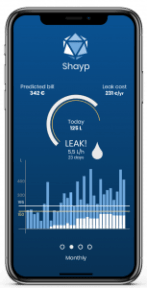
Whether it’s a question of repairing or maintaining a building’s plumbing, maintenance teams are not done yet with water leaks. Today, technology is at the service of these technicians. It brings a new dimension to their work, a more digital one that allows them to manage their daily interventions more efficiently. Adopting a digital preventive maintenance tool saves time, prioritises interventions and avoids over-consumption.
Shayp – a platform for monitoring water consumption
With the advent of machine learning, the solutions on the market are becoming increasingly powerful and intelligent. They produce data that can be processed and analysed to provide a complete view of the condition of the building, current leaks and projected costs if no repairs are made. A simple data sensor reads the water meter and sends the data to the server. Analysed, this data will enable the connected buildings to be prioritised according to the size of the leak. The most expensive one is at the top of the ranking. All the information is continuously updated. The costs and risks of leaks are continuously calculated.
Intelligent technology such as the Shayp solution helps maintenance teams to become more proactive and anticipate interventions because the analysis of water consumption in real time gives a direct insight into water leaks and anomalies in the plumbing system. An informed technician will invest in this type of monitoring platform to facilitate and schedule his interventions on a day-to-day basis.
Reactive maintenance and alerts
The installed sensors provide alerts when an anomaly or water leak is detected on the network. These alerts take the form of an SMS or an email and are sent directly to the responsible technicians. Maintenance teams can thus be alerted in time and deploy the necessary resources to carry out repairs. The status of each intervention is recorded directly in the platform. 
This is followed by the question of searching for the water leak or anomaly detected. The information about the leak is presented in the platform and gives, among other things, an indication of the number of litres lost, so that maintenance teams know where to look for the leak and plug it.
For example, a leaking toilet represents about 25 litres per hour. A thin trickle of water is about 16 litres per hour and a drip about 4 litres per hour.
Leak-detection technicians
Some practical advice, the steps to follow to find a water leak are as follows:
- Intervention in the sanitary facilities.
The first place the technician should go is the sanitary facilities. In 80% of the cases, the leak is located at the taps, flushing systems,… Automated machines such as water softeners, boilers, urinals, automatic sprinklers, etc. are also affected. Sometimes a simple gesture is all it takes to stop the flow of water (closing the tap, connecting, or changing a component, to name but a few).
- Intervention of “water leak hunters”.
In a second step, all visible pipes must be checked. The building is screened by the technicians. Either the repair can be done directly or a plumber will have to be commissioned.
- Intervention of the “water leak searchers”.
If the water leak is invisible, hidden or buried, the technician will have to call in an external company that has the necessary leak detection equipment (camera, thermography, colorimetry, ….).
Is the leak detected and/or plugged? The technician enters the status of the intervention in the platform and moves on to the next intervention. The rate of water loss is automatically recalculated and the savings achieved are displayed. The building that is free of leaks is then lowered in priority and another building is put at the top of the list.
With the help of real and numerical data, Shayp shows how maintenance teams are empowered and can make decisions. The building owner can only come out a winner.
Find our article and many others dealing with preventive maintenance on www.urbest.io, the collaborative tracking platform that allows organizations to capture, organize, track and put into action the workload between requesters, managers and stakeholders!


